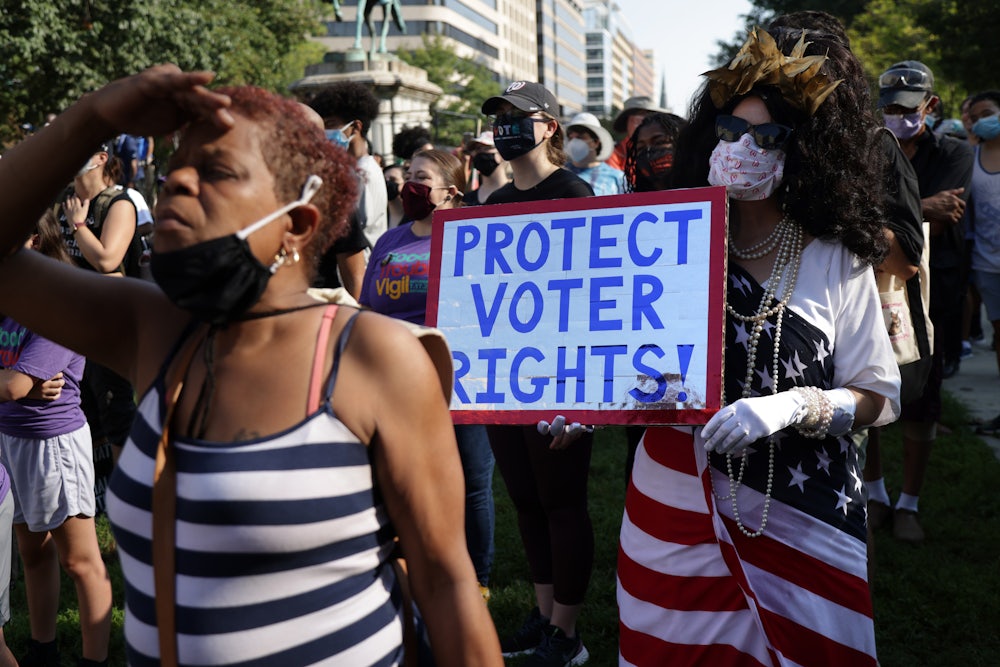“Every American citizen must have an equal right to vote. There is no reason which can excuse the denial of that right,” proclaimed President Lyndon B. Johnson in 1965, during a joint speech to Congress at the crux of the Civil Rights Movement. At that moment, outside of the walls of the Capitol, the country was at its wits’ end. Anti-democratic forces in the South were determined to stop Black Americans from voting. In response to pressure from civil rights activists, President Johnson signed the Voting Rights Act of 1965, landmark legislation that set out to ban discrimination at the ballot box.
This week marks 58 years since the signing of the VRA, and for all the progress our country has made, every American citizen still does not have their right to vote. Our democracy is not as strong as it should be. Take a look at what’s happening in Alabama, the same state where Martin Luther King Jr. marched to end the systemic racist structure of the Jim Crow South.
This summer in the landmark Supreme Court case Allen v. Milligan, Alabama was told by the court to redraw gerrymandered congressional maps. The court in a rare move argued the maps violated the VRA and limited the political power of Black Alabamians. And yet, despite the Supreme Court’s decision, the state has refused to comply and has drawn new maps that do not address the racial gerrymandering present in Alabama.
In Ohio, a sweeping election law package has been recently enacted, removing non-photo IDs from the list of acceptable identification and restricting the number of ballot collection boxes to one per county. Given Ohio’s substantial population of nearly 12 million people, this move is counterproductive in facilitating easier access to voting for its residents.
As we commemorate this anniversary, it’s apparent the democratic safeguards civil rights activists fought for are being taken away—not only by states like Ohio and Alabama, but by the Supreme Court as well. While the Allen v. Milligan decision provided a small win, the court’s past ruling in Shelby County v. Holder delivered critical blows to the VRA.
Prior to the Shelby decision, states and counties with the worst histories and recent records of voting discrimination had to obtain “federal preclearance”—that is, approval from the Department of Justice or a federal court—before implementing any changes to voting laws and practices, to ensure they did not curtail the right to vote. In the Shelby County decision, the court struck down the formula used to identify which states were required to obtain federal preclearance, effectively gutting the heart of the VRA.
As both the Supreme Court and individual states weaken the VRA, coupled with a divided Congress that cannot enact commonsense voting rights legislation, protecting our democracy falls to states with the capacity to take action. America can’t wait for voter protections, especially with a monumental presidential election approaching in 2024. While enacting federal legislation is essential for fully restoring the strength of the VRA, states are not completely helpless. States can implement commonsense solutions to address some anti-democratic flaws in our voting systems. New Mexico and Connecticut serve as prime examples of this proactive approach.
In New Mexico, the governor recently signed the state’s inaugural Voting Rights Act. This legislation automatically registers voters at the Department of Motor Vehicles or other designated local public offices, reinstates voting rights for previously incarcerated individuals upon their release from custody, mandates a minimum of two monitored secure ballot drop boxes per county, and much more.
Connecticut is adopting a similar approach with its Voting Rights Act. The state has enacted a “preclearance” program that necessitates local governments with a history of discrimination demonstrate that proposed voting changes won’t harm voters of color before implementing them. Connecticut’s law also enhances language assistance for voters with limited English proficiency and establishes robust protections against voter intimidation, deception, or obstruction.
These legislative triumphs in New Mexico and Connecticut exemplify a clear template for other state legislatures to follow in passing pro-democracy laws. The threats to our democracy must be taken seriously, especially with the possibility of former President Trump’s return to the ballot—a politician openly disdainful of an open democracy. It is crucial that every possible measure is taken to protect the right to vote. As the Supreme Court slowly undoes the progress of the Civil Rights Movement and Congress remains gridlocked, states can rise to the occasion by emulating the success of Connecticut and New Mexico, mitigating the trauma inflicted on our democracy. Waiting is not an option; we must start the process of resuscitating our democracy now.






